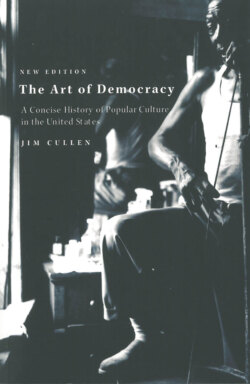The Art of Democracy

Реклама. ООО «ЛитРес», ИНН: 7719571260.
Оглавление
Jim Cullen. The Art of Democracy
About NYU Press
THE ART OF DEMOCRACY
CONTENTS
PREFACE TO THE SECOND EDITION
INTRODUCTION
CHAPTER ONE. NOVEL APPROACHES: THE RISE OF POPULAR CULTURE
GETTING THE WORD: THE ORIGINS OF A POPULAR AUDIENCE
OPENING CHAPTERS: THE RISE OF THE NOVEL
A CLOSER LOOK: A Temple of the Imagination
CHAPTER TWO DEMOCRATIC VISTAS: THE EMERGENCE OF POPULAR CULTURE, 1800-1860
CLASS OPERATIONS:THE BIRTH OF THE MASS PRESS
THE CURTAIN RISES: ANTEBELLUM PERFORMING ARTS
A CLOSER LOOK: The Astor Place Riot
DECEPTIVE SIMPLICITY: SHOW BUSINESS IN THE AGE OF BARNUM
TRANSGRESSING LINES: ANTEBELLUM POPULAR NARRATIVE
A CLOSER LOOK: The Art and Life of Fanny Fern
CHAPTER THREE. STAGES OF DEVELOPMENT: THE SEGMENTATION AND CONSOLIDATION OF POPULAR CULTURE, 1860-1900
SOUNDS OF FREEDOM: TOWARD AN AFRICAN-AMERICAN POPULAR CULTURE
EXPANSIVE VISTAS: POPULAR CULTURE IN THE WEST
ENTERTAINING PROPOSITIONS: THE CULTURE OF THE URBAN WORKING CLASS
A closer look: The Dark Humor of Bert Williams
A closer look: Coney Island
CHAPTER FOURMEDIATING COMMUNITIES: POPULAR CULTURE AND MODERN TECHNOLOGY, 1900-1945
MOVING IMAGES: THE RISE OF FILM CULTURE
A CLOSER LOOK:Chaplin’s Business
RECEDING LINES: OLD FORMS IN A NEW CENTURY
MAKING WAVES: THE DAWN OF BROADCASTING IN THE UNITED STATES
GIANT STEPS: THE EMERGENCE OF MODERN POPULAR MUSIC AND DANCE
A closer look:Billie Holiday, The Jazz Singer
CHAPTER FIVE. SMALL SCREENS: POPULAR CULTURE IN THE AGE OF TELEVISION AND BEYOND, 1945 - 2000
SHOWS OF FORCE: THE BIRTH OF TELEVISION
A CLOSER LOOK:ABunker Mentality
SMALLER ROLES: MOVIES IN THE AGE OF TV
PLAYBACK: THE ARRIVAL OF HOME VIDEO
NEW CHAPTERS: THE “PAPERBACK REVOLUTION”
REWIRED: RADIO’S TRANSFORMATION
LET’S GO TO THE (HIP) HOP: POSTWAR POPULAR MUSIC
A CLOSER LOOK:The Integrated Sound of Los Lobos
A CLOSER LOOK:The Mixed Media of MTV
CHAPTER SIX. HARMONIC CONVERGENCE? ACROSS THE DIGITAL FRONTIER
CIRCUITOUS LOGIC: THE DEVELOPMENT OF COMPUTER HARDWARE
CODED COMMUNICATION: THE ASCENDANCE OF COMPUTER SOFTWARE
FORGING LINKS: THE (COLLECTIVE) CREATION OF THE INTERNET
CONCLUSION: THE PROMISE AND PERIL OF INTEGRATION
A CLOSER LOOK: Your Idea Here
FURTHER READING: A NOTE FOR THE SECOND EDITION
INTRODUCTION. Notes
Chapter One: NOVEL APPROACHES. For Further Reading
Notes
Sources for“ATemple of the Imagination”
Chapter Two: DEMOCRATIC VISTAS. Further Reading
Notes
Sources for “The Astor Place Riot”
Sources for “The Art and Life of Fanny Fern”
Chapter Three: STAGES OF DEVELOPMENT. Further Reading
Notes
Sources for “Coney Island”
Sources for “The Dark Humor of Bert Williams”
Chapter Four: MEDIATING COMMUNITIES. Further Reading
Notes
Sources for “Chaplin’s Business”
Sources for “Billie Holiday, The Jazz Singer”
Chapter Five: CHANNELED ENERGY. Further Reading
Notes
Sources for “A Bunker Mentality”
Sources for “The Integrated Sound of Los Lobos”
Sources for “The Mixed Media of MTV”
Chapter Six: HARMONIC CONVERGENCE? Further Reading
Notes
INDEX
Отрывок из книги
Thank you for buying this ebook, published by NYU Press.
Sign up for our e-newsletters to receive information about forthcoming books, special discounts, and more!
.....
Perhaps the most well-known play about Native Americans was John Augustus Stone’s Metamora (1828), commissioned by Edwin Forrest, the most famous actor of his day. The story of an Indian chief who perished fighting New Englanders in King Philip’s War of 1675-1676, Metamora features the usual depiction of the noble savage who patiently endures his mistreatment by the white man. What makes this play unusual, though, is that Metamora finally strikes out against his oppressors. “Our Lands! Our nation’s freedom! Or the Grave!” he cries. Finally surrounded, he kills his wife rather than have her raped by whites, then dies with her name on his lips. In his passion for freedom—which evokes Patrick Henry’s famous slogan “Give me liberty or give me death!”—and in his possessive sexual anxiety about women, Metamora seems more white than red. Of course, he represents a white man’s idea of what a great Indian should be, and his dramatic actions at the end of the play were probably as much calculated to show off Forrest’s physique and generate standing ovations as to make a political statement. But the play was nonetheless a genuine critique of white policy toward Indians. “Let us hope, for the honor of humanity, that this applause is bestowed on Mr. Forrest, rather than the ferocious savage he impersonates,” said a reviewer in the American Quarterly Review in 1830. In all likelihood the writer need not have worried, for the pace of aggression toward Indians did not slow in any perceptible way. Moreover, Robert Bird, who helped revise the play to suit Forrest’s purposes, later became the author of Nick of the Woods (1837), a novel that essentially justified a policy of extermination.35
By the mid-nineteenth century, Native Americans were a dwindling group living outside white society. African Americans, by contrast, were part of a racially hierarchial system within white society, and their numbers were increasing. These facts help account for the different treatment of the two groups on the stage. A disappearing danger, Indians were often romanticized, the subject of nostalgia for a vanishing world. Black-white relations, on the other hand, were a subject of increasing conflict and uncertainty.
.....